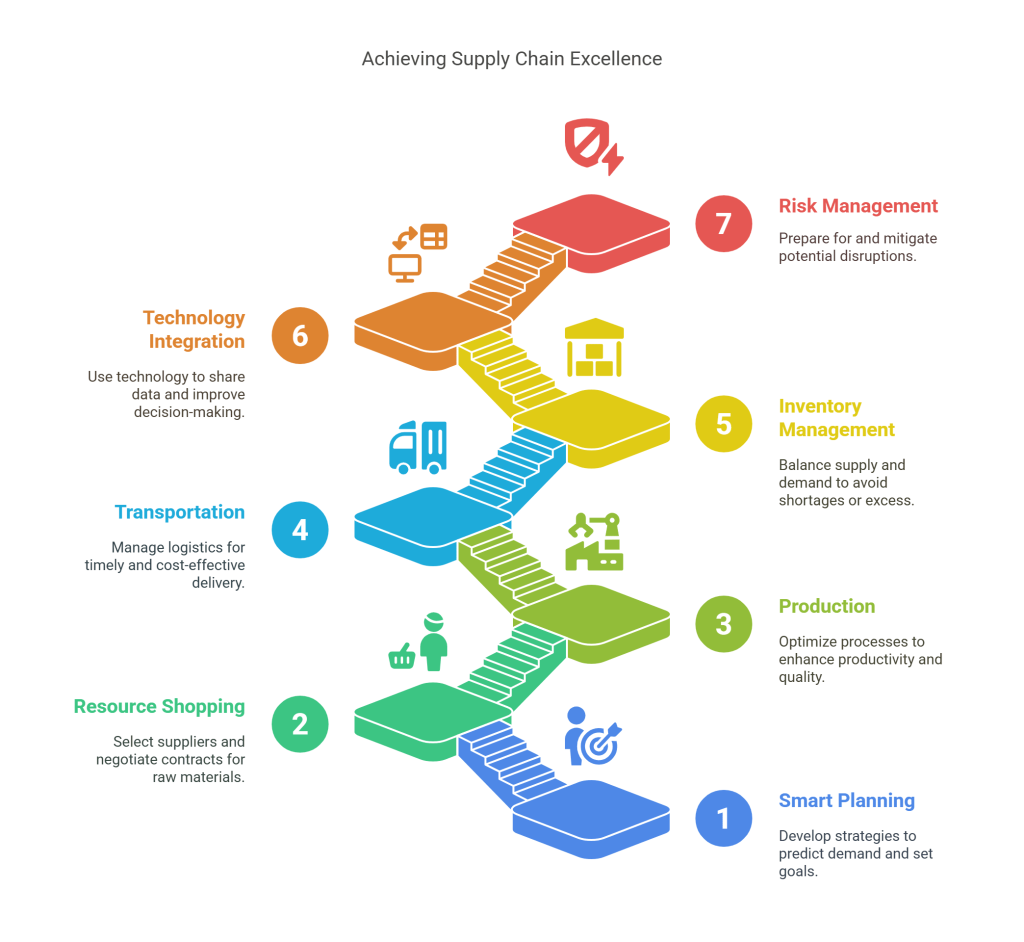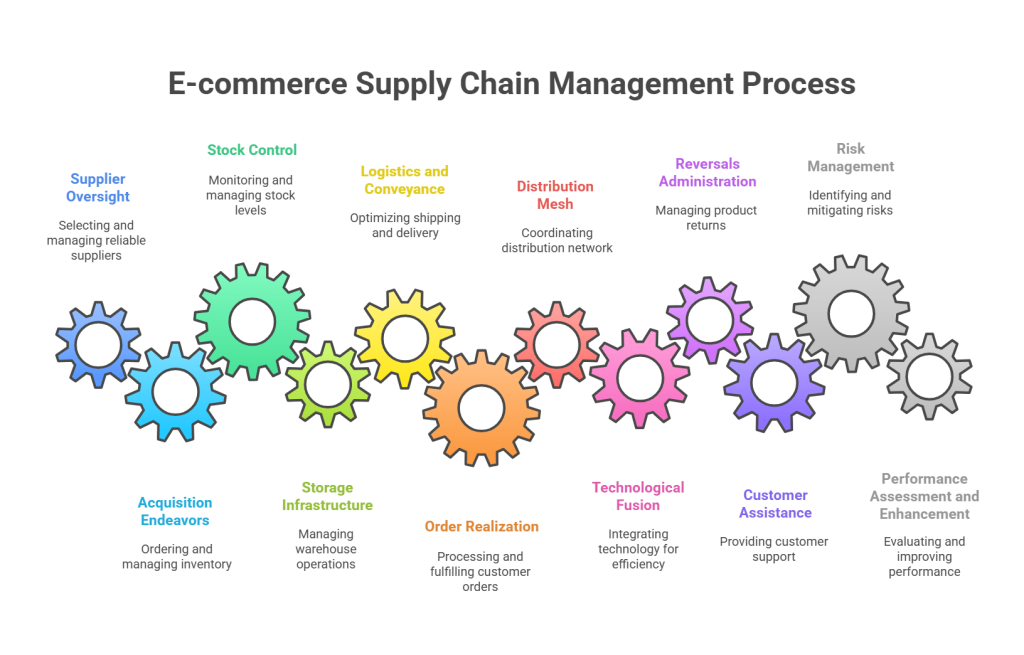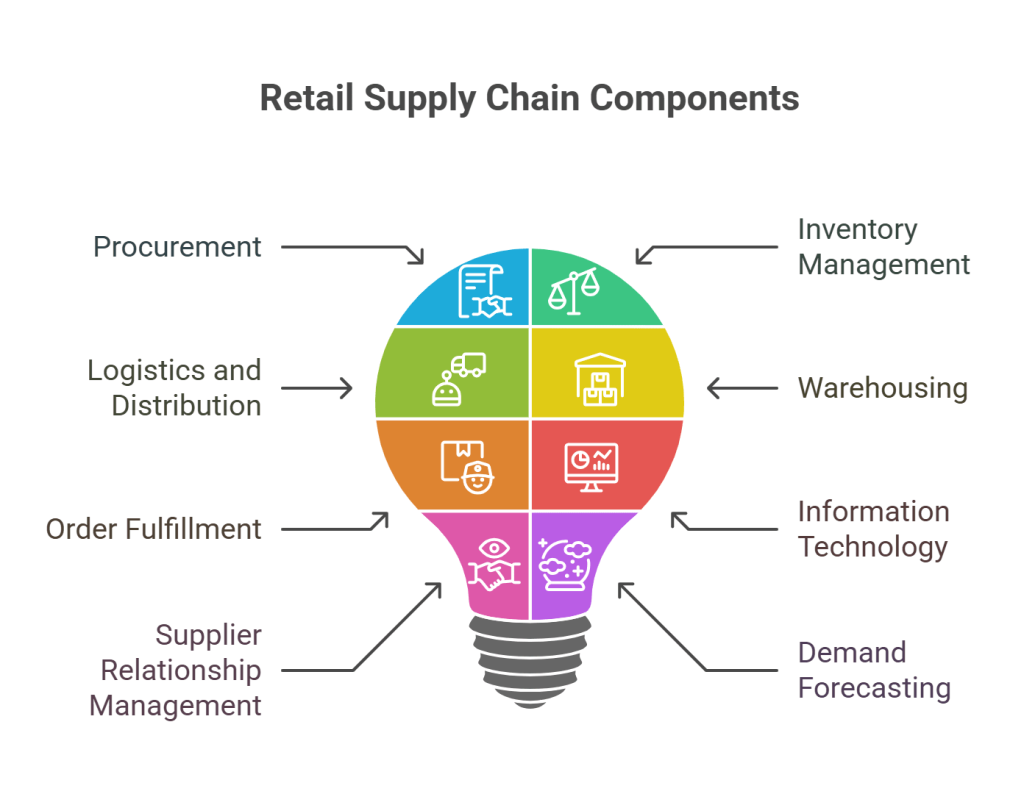
Introduction
In what manner does the complex network of interlinked processes within the domain of supply chain management mold the triumph of businesses spanning diverse industries? The effectiveness of these procedures possesses the potential to deeply impact a company’s comprehensive performance and its capability to meet the continually shifting demands of customers. Let’s embark on an exploration into the crucial sphere of supply chain management, unraveling the intricate roles played by its seven fundamental components.
Components of supply chain management

Now, let’s dance through the components of supply chain management, the intricate art of making things flow smoothly from creation to delivery.
1. Smart Planning:
In the ever-changing world of business, smart planning is the rockstar of a kick-butt supply chain. It’s like predicting the future demand, spotting possible problems, and setting clear goals to keep everything in sync with the big business dreams. Strong strategies help businesses tackle issues head-on and make their supply chain super efficient.
2. Shopping for Resources:
If supply chain management were a shopping spree, this phase would be the highlight reel. It’s all about picking the right suppliers, haggling over contracts, and grabbing the raw materials that make everything tick. A streamlined shopping process means a steady supply of top-notch stuff, making your chain resilient in the face of market twists and turns.
3. Making Stuff or Doing the Service Thing:
Whether you’re crafting things or serving up solutions, the production phase is where the magic happens. It’s about fine-tuning processes to boost productivity, cut down on waste, and hit those quality goals. Smooth production lines up with what customers want and keeps the flow of goods or services sailing through the supply chain.
4. Moving Stuff Around:
Picture this as the journey of goods, from where they’re made to where they’re needed. Effective moving involves a top-notch transportation network and smart logistics management, ensuring deliveries are on time and costs stay low. Tech helpers like GPS tracking and route optimization add an extra layer of finesse.
5.Stuff in Storage:
Keeping the perfect balance between supply and demand requires some inventory magic. This part is all about keeping an eye on stock levels, predicting when things might get crazy, and using smart tricks to control inventory. With the help of tech and data smarts, businesses dodge running out of stuff, cut down on holding costs, and run super smooth operations.
6. Tech Buddy Time:
Welcome to the digital age, where adding a dash of tech is the secret sauce to supply chain success. It’s like plugging in information technology to share data lightning-fast, so everyone can make quick decisions. This means using fancy software, diving into data for cool insights, and tapping into cool tech like the Internet of Things (IoT) to see the whole supply chain picture.
7. Trouble Handling:
Life is unpredictable, and so is the supply chain. Trouble handling is all about spotting potential issues, having backup plans ready, and using strategies to tackle problems. From global challenges to natural disasters, a solid trouble-handling approach ensures the business keeps going even when things get tough.
Components of supply chain management in ecommerce

In the world of online shopping, making sure things run smoothly from the start to when you get your package involves coordinating lots of different parts. Exploring how this all works in e-commerce, you find it’s like untangling a web of details, with lots of twists and turns. Let’s dig into the important pieces that make this whole process tick:
1. Supplier Oversight:
Proficiently discern and opt for dependable suppliers, engage in negotiations for contracts, and meticulously scrutinize supplier performance to foster resilient partnerships.
2. Acquisition Endeavors:
Commence orders, adeptly administer inventory, and deploy procurement strategies for the optimization of costs in obtaining raw materials or finished goods.
3. Stock Control:
Monitor and govern stock levels vigilantly, execute well-organized order fulfillment procedures, and leverage inventory management software for immediate tracking.
4. Storage Infrastructure:
Consciously select and oversee warehouse locations, devise efficient layouts, and integrate cutting-edge technology for the mechanization and refinement of warehouse operations and Storage infrastructure.
5. Logistics and Conveyance:
Discern optimal shipping methods, streamline delivery routes, and incorporate real-time tracking of shipments for enhanced visibility.
6. Order Realization:
Execute customer orders with meticulous precision, carry out systematic picking, packing, and dispatch, and furnish clientele with order tracking and status updates.
7. Distribution Mesh:
Devise a robust network of distribution hubs, optimize the distribution network for prompt deliveries, and ensure seamless coordination between diverse distribution points.
8. Technological Fusion:
Instigate e-commerce platforms and software for the orchestration of orders, employ data analytics for demand prognosis, and integrate systems enabling real-time communication and collaboration.
9. Reversals Administration:
Formulate an efficient protocol for managing product returns, scrutinize returned items for potential resale or disposal, and analyze return data to precisely pinpoint and rectify recurring issues.
10. Customer Assistance:
Provide timely and insightful support to clients, adeptly manage inquiries, resolve grievances, and extract valuable insights from customer feedback. To optimize the overall efficiency of the supply chain process Strategically utilize customer data.
11. Risk Management:
Recognize and tackle potential hazards ingrained in the supply chain, craft strategies for unexpected scenarios, and guarantee unwavering compliance with regulatory requirements and industry standards.
12. Performance Assessment and Enhancement:
For performance assessment, pivotal performance indicators (KPIs) are established to portray the efficacy of the supply chain. Consistent evaluation and scrutiny of metrics drive perpetual enhancement guided by insights from comprehensive data analysis, ensuring continuous improvement.
Components of retail supply chain management

1. Procurement:
Procurement stands as a meticulous and systematic process integral to retailers’ acquisition of products for customer offerings. This intricate journey involves establishing robust relationships with suppliers, engaging in intricate contract negotiations, and maintaining a vigilant approach to product stock management. The primary objective is seamless alignment with customer demand, achieved through precision and strategic orchestration.
2. Inventory Management:
Within the realm of Inventory Management, the focus transcends mere systematic control and organization. The overarching goal is precision, ensuring the optimal quantity of products is available precisely when required. This strategic approach skillfully navigates the challenges of both overstock and stockouts, emphasizing the importance of meticulous planning and execution.
3. Logistics and Distribution:
Post-procurement, Logistics and Distribution take center stage, evolving beyond simple transportation. It transforms into a strategic dance, demanding effective planning and flawless execution. The emphasis lies in optimizing efficiency and minimizing costs within this intricate web of movements, providing a technical edge to the entire supply chain.
4. Warehousing:
Warehousing, acting as the central nerve of a retailer’s inventory, transcends the conventional notion of a storage space. These meticulously organized hubs are responsible for the reception, categorization, and expert management of products. This occurs before the products embark on their journey to various retail locations, showcasing a technical prowess in inventory handling.
5. Order Fulfillment:
Order Fulfillment emerges as a critical link, seamlessly bridging a customer’s order to the reception of the desired product. This intricate process involves the technical expertise of picking the right products from inventory, packing them meticulously, and ensuring a streamlined delivery process for an optimized and satisfying customer experience.
6. Information Technology:
In the contemporary retail landscape, Information Technology assumes the role of an unsung hero. Its crucial contribution involves the deployment of sophisticated systems for real-time tracking of inventory levels, efficient order management, and insightful data analysis. Technology becomes the linchpin, fostering informed decision-making and the streamlined optimization of supply chains at a technical level.
7. Supplier Relationship Management:
Supplier Relationship Management transcends a mere transactional affair, evolving into an art form. The emphasis is on building and sustaining robust relationships with suppliers through effective communication and collaboration. This technical adaptability becomes particularly vital in navigating the ever-changing dynamics of the market, showcasing a nuanced approach.
8. Demand Forecasting:
Ultimately, Demand Forecasting emerges as the focal point, akin to a data-driven visionary. Retailers leverage the potential embedded in data and analytics to intricately anticipate customer demands with precision. This proactive insight becomes the guiding force behind pivotal inventory decisions, empowering retailers with the optimal quantity of products. This ensures a seamless response to the ever-evolving preferences of consumers, spotlighting a technical prowess and mastery in the realm of predictive analytics.
Conclusion
In the intricate world of supply chain management, the success of businesses relies on the synergy of seven essential components. From strategic planning to risk management, each element plays a crucial role in refining processes, ensuring punctual deliveries, and surpassing customer expectations. Amidst the ever-changing business landscape, a well-managed supply chain emerges as a strategic asset of unparalleled value. Partner with Qodenext, a brand synonymous with innovative solutions, to elevate your supply chain success.
FAQs
1. Why is strategic planning the cornerstone of effective supply chain management?
Strategic planning is vital, forecasting demand, identifying risks, and aligning the supply chain with overarching business goals, ensuring proactive navigation of challenges.
2. How does inventory management contribute to a balanced supply chain?
Inventory management maintains equilibrium by tracking stock levels, predicting demand changes, and implementing measures to avoid shortages, reduce holding costs, and enhance efficiency.
3. What impact does information technology integration have on supply chain success in the digital age?
Information technology integration is crucial, empowering stakeholders with real-time data sharing, robust software solutions, and technologies like the Internet of Things (IoT), enhancing visibility for overall success.
4. How does effective trouble handling contribute to supply chain resilience?
Trouble handling anticipates and addresses potential disruptions, ensuring business continuity in the face of challenges, from global issues to natural disasters.
5. Why is customer assistance a critical component in supply chain management?
Customer assistance ensures timely support, grievance resolution, and valuable insights from feedback, optimizing overall efficiency and enhancing customer satisfaction.
6. What is the significance of performance assessment in continuous supply chain improvement?
Performance assessment through key performance indicators (KPIs) drives perpetual enhancement, guided by insights from comprehensive data analysis, ensuring continuous improvement.






